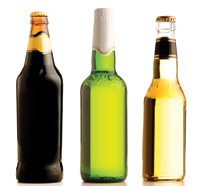Beer is booming. This may seem blatantly obvious considering the rise of craft beer, which has been experiencing double-digit growth. And, there’s also the decade-long upsurge in the sales of imported beer, more of which is being consumed in Canada today than ever before. Yet, overall, the beer market has been growing at a fairly glacial pace during the past dozen years.
In fact, according to Statistics Canada, while the population of Canada increased by approximately 12 per cent from 2000 to 2012, total beer sales during that same period grew by only eight per cent. This is reflected in a per-capita beer consumption decline of almost five litres per person since the dawn of the new millennium.
Still, the best performer has been craft beer. Although precise numbers for the country are difficult to gather, it is telling that the LCBO in Ontario, almost certainly the nation’s top seller of craft beer, reports 746-per-cent craft beer sales growth in the last decade. Also notable has been the increase in the sales of imported beer in Canada, which has more than doubled in volume between 2000 and 2012.
Such news has contributed to unprecedented beer selection for restaurateurs and the question of which beers are best to stock: imports, regular domestics or craft beers? “The advantage [of imported beers] for us is that it gives us a distinction; people come in expecting to taste
beer they’ve never had before,” says Justin Tisdale, GM of Vancouver’s Chambar, which stocks almost exclusively Belgian beers, from draught La Chouffe to the rich and potent Rochefort 10. “I won’t say anything bad about our local brewers — there are some great beers — but they are a little more widely available than the beers we carry.”
The yin to Chambar’s yang is C’est What?, an establishment that has sold exclusively domestic craft beers, principally from Ontario brewers such as King and Black Oak, for most of its 25 years in Toronto’s downtown core. “One of the advantages [of domestic craft beer] is you get to deal directly with the brewers rather than a third party, and they tend to give better customer service,” says George Milbrandt, C’est What? co-owner. “Beer is best consumed fresh, and beer that is brewed close to you is the freshest.”
Of course, domestic craft beer also offers the added attraction of premium pricing, as do imported beers. The major domestic brewers, such as Molson and Labatt, may still account for the bulk of Canadian beer sales — by most estimates, more than 80 per cent of overall beer sales in 2012, down roughly 10 per cent from 2000 — but a casual survey of Toronto beer destinations shows that crafts and imports can command up to $1.50 more per pint. It’s less important when imports can command a hefty 50-per-cent keg price premium but a significant amount when you consider that some craft beers are priced competitively with mainstream domestics.
In the end, what you stock should be a reflection of the message you are trying to send your clientele. Are you a premium place of discovery, like Chambar; a champion of local brewers, like C’est What?; or a comfortable purveyor of the tried and tested?
Stephen Beaumont is the author of eight books about beer, including his latest, The Pocket Beer Guide, co-written with Tim Webb, and available this month. He can be reached at [email protected].




















